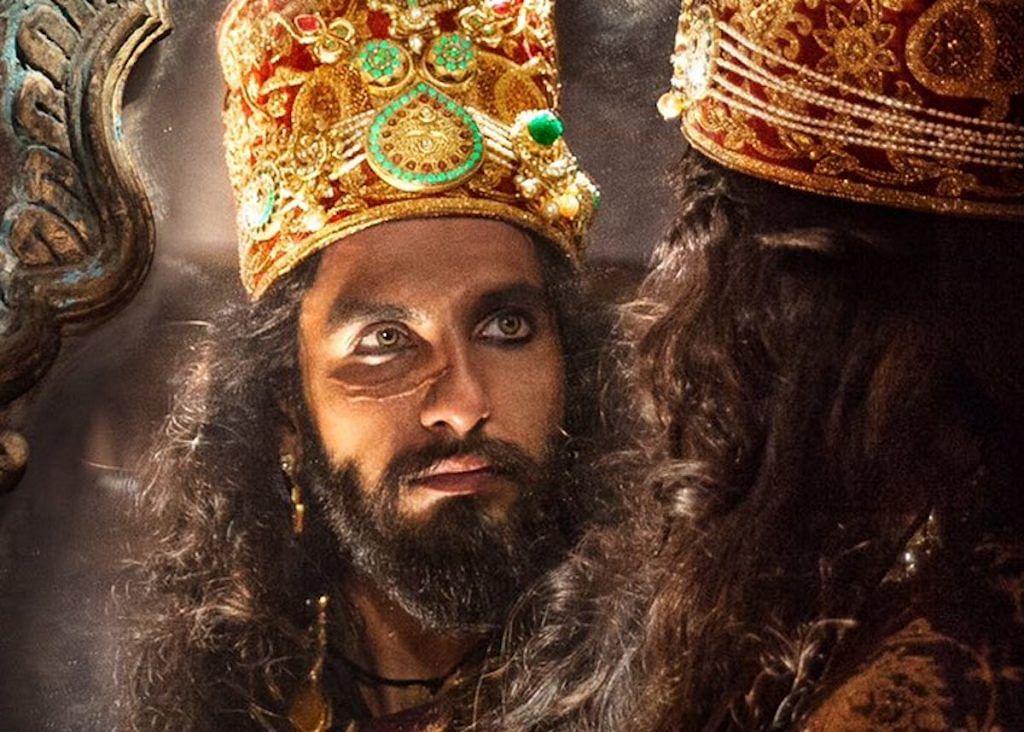The trailer of the film Padmavati is rooted in the practice of using pop-culture to give legitimacy to patriarchal notions of women’s bodies and caste stereotypes.
The recently-released Padmavati trailer’s portrayal of Delhi’s Turkic ruler Alauddin Khilji shows a caricature of a menacing figure who savagely eats meat, wears furs, and resides in gloomy, dark spaces. The Rajput characters are shown in brighter, softer lighting. By contrast, the use of low-lighting, shadows and harsh sounds for Khilji typecasts him as the film’s stock villain.
The problem, however, is that some versions of history show varying accounts of Khilji’s reign from Delhi between AD 1296 to 1316. Historical accounts discuss how Khilji and his armymen defended Hindustani territories from Mongol invasions, and how his rule set up an economic system with benefits for peasantry.
Narratives of tyranny mark how we remember Aurangzeb or Khilji’s rule today, but as historian Audrey Truschke puts it, “Condemnations of Aurangzeb and other medieval Indian rulers stem not from a serious assessment of the past but rather from anxieties over India’s present and future.”
While we must recognise many of the wrongs committed by such rulers, it is also necessary to be mindful of how popular culture and myth-making depict India’s Muslim kings. Atrocities, conquests and violence are features of all monarchies and empires, including Hindu ones.
The dominant depiction of Khilji is also a testament to our times, where the Muslim man is impaled as an alien ‘Other’, out to impinge on a (Hindu) Rajput woman’s ‘honour’. A cursory glance at such relationships in Bollywood movies shows how inter-faith romance is more acceptable when the woman is Muslim, such as Ishaqzaade or Gadar, but when the man is Muslim it often has the context of terrorism as in Kurbaan, or My Name is Khan.
In the times of the right-wing’s “Love-Jihad” bogeyman, the sub-text is evident. For the Hindu man to win over the Muslim woman marks a conquering, in a deeply patriarchal notion, of the supposed ‘Other’.
In Veer-Zaara, the Pakistani Muslim Priety Zinta’s character ultimately gives up her life in Lahore to live with Veer in India. The controversy over any hint of a potential dalliance between Khilji and Padmini shows not just cinema’s tensions, but also our collective anxieties when it comes to a romance between a Muslim man and Hindu woman.
History shows that Khilji captured Chittorgarh from its ruler Ratan Singh in 1303 AD, but the legend of Padmavati is said to have emerged only around the 16th century after Awadhi poet Malik Muhammad Jayasi composed a poem titled Padmavat. The Rajput re-appropriation of this poem, which actually narrates the fall of Chittor, has focused on caste consolidation by stressing on themes of Rajput ‘valour’ and ‘honour’.
The poem talks of Khilji’s army defeating the Rajputs only to find out that Rani Padmini, and other Rajput women have committed mass self-immolation (Jauhar) by then. Today, these anecdotes have become the stuff of legend, immortalised as fact instead of fiction by some Rajput groups.
The movie trailer reiterates the same with dialogues such as, “Rajputi kangan mein utni hi taakat hai jitni Rajputi talwar main (Rajput bangles have as much strength as the Rajput’s sword)”. These dialogues may seem harmless, but in effect perpetuate gender stereotypes and caste essentialism by ascribing the character traits of “bravery”, “valour” and “strength” to the Rajput caste, and fuel a sexist notion of women’s worth being seen only through objects like bangles.
This isn’t a new phenomenon in Hindi cinema or India. When Shah Rukh Khan’s Raees came out with the accompanying tagline, “Baniye ka dimaag aur miyaanbhai ki daring (A Bania’s acumen, and the daring of a Muslim)”, many of us as Savarna audience easily ignored the subtext.
The idea that the mercantile vaishya caste groups are “street smart” and “business savvy”, while the Muslim (man) is a figure of hyper-masculine daring are notions that are linked to popular culture and our social conditioning. This is akin to how ‘knowledge’ and ‘intelligence’ are associated with Brahmins, and ‘bravery’ with Kshatriya castes.
Rarely has cinema and popular culture used the same glorification of traits and personality attributes for Dalit-Bahujan caste communities. Instead, we have movie song lyrics like the one from Aaja Nachle, which locks you into your caste-based occupation: “Bole mochi bhi khud ko sunaar (even a cobbler calls himself as a goldsmith)”. This was later banned after protests.
Dominant caste communities have long tried to uphold both caste supremacy and patriarchal ideals by policing the bodies of women, and references notions of ‘honour’ and ‘modesty’.
Lastly, women have always been seen as flagbearers of the honour of a community, kingdom and a nation. From the times of the Partition itself, real-life examples show how women were pressured into committing mass-suicides lest they would be ‘captured’ by men from the other community. It presumes that women’s lives were worthless after being assaulted, a sentiment deeply embedded in rape culture.
Padmini’s act of self-immolation is glorified as Jauhar, something often detached from the violence of sexism and Islamophobia underpinning it. Glorifying women’s suicides as ‘heroic self-sacrifice’ is a toxic idea that deifies these women, instead of seeing them as “honour” killings.
While it maybe too early to conclusively call the film sexist and casteist, its trailer is nevertheless rooted in presenting a toxic history and the practice of using pop-culture to give legitimacy to patriarchal notions of women’s bodies.
Sabah K. is a journalist who was harassed and sent death threats online after writing a Facebook post on the film’s trailer.
